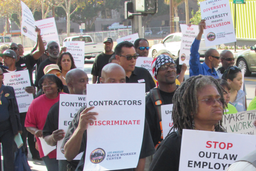
At the Victoria’s Secret flagship location in Manhattan’s Herald Square, where all three floors are frequently packed with customers, a single bra can sell for $58 and customers often drop hundreds of dollars in a single spree. Yet wages for the company’s New York City retail workers can start at less than $10 an hour, and employees say unreliable scheduling means that a consistent paycheck is never a guarantee.
After an employee-led campaign against the location’s district manager, however, Victoria’s Secret employees are beginning to see improvements. Workers at the Herald Square store recently received raises of as much as two dollars an hour.
Led by a small cohort of veteran employees who felt mistreated by years of low pay, fluctuating schedules and a dearth of advancement opportunities, the campaign consisted of letters to management, petition cards signed by more than one hundred employees and an online petition.
The employees were assisted in their efforts by a local workers’ center, the Retail Action Project (RAP), which is affiliated with the Retail, Wholesale and Department Store Union (RWDSU) and which collaborated with Victoria’s Secret workers as part of its “Just Hours” campaign to organize retail workers in New York. In January of 2012, with CUNY’s Murphy Institute, the project released a report on working conditions in the sector that found that “approximately one-third of [the 436] surveyed retail employees support family members on their wages, yet the median wage for surveyed workers is only $9.50 an hour” — nearly impossible to survive on in Manhattan, and right in line with many starting salaries at Victoria’s Secret.
“We went to them because we needed better hours for ourselves, and better pay,” says one of the members of the organizing committee, who asked that In These Times refer to her only by her first initial, D. D., 27, has been working in the Victoria’s Secret megastore since October 2010.
With the help of the center, D. and two of her coworkers delivered an unsigned letter expressing employees’ grievances about pay, scheduling and promotions to their store manager. The trio of workers also began collecting petition cards and asking their coworkers for signatures of support. Within two weeks of the first letter, the workers delivered a second one, this time including a half dozen signatures from the newly expanded organizing committee and demanding a meeting with the manager to discuss their complaints by the following week.
Once a group of workers had put their names on the letter, committee leaders say that management began to retaliate. Organizers report that experienced employees were temporarily put in entry-level positions, and some signers’ hours were cut. “The [week after we delivered the letter] I had probably only ten hours, and that was never the case [before],” D. explains. “I’ve never, never dropped that low.”
According to D., management claimed that falling sales had led to the schedule changes, but she saw them as a warning. In addition to her reduced hours, she was separated from the rest of the workforce in the stock room and tasked with multiple employees’ jobs at once without help. “I felt like they were trying to isolate me from everybody else,” she says.
In addition to this pushback, D. and representatives from RAP say that the corporation’s Ohio headquarters began a strong anti-union campaign to head off any formal organizing. Despite management’s reported continued refusal to meet with the workers’ committee as a group, employees say human resources representatives began to survey the shop floor about working conditions. Limited Brands, the company that owns Victoria’s Secret, did not respond when called for comment.
“After that,” remembers D., “they started having meetings with everyone in the store.” The minor agitation appeared to have conjured fears of unionization: The representatives began holding mandatory anti-union meetings, says D., telling employees “that they want your dues.”
“But that was never the case,” D. explains. “We never said anything about a union, but [management] scared everyone. So we lost a lot of people that were following us, because they thought that we were lying to them, and that the company was right.”
In spite of these setbacks, the group continued its push for improvements. After an online petition became the basis for the workers’ third letter to management, the company announced at the beginning of August that it would increase wages across the board, with the raises scaled to seniority. This meant the veteran core of the organizing committee would receive high bumps. The company claimed that the change was in response to a yearly employee satisfaction survey given months prior.
Many employees, however, feel that their protests were a direct factor in the decision. “They do [the survey] every year,” D. explains, “But this was the first time it’s ever had any kind of action afterwards … We know that it wasn’t [the survey], because they didn’t really have a reason to [raise pay] until we actually started speaking up.” When contacted for this story, representatives from the store would not respond for comment.
Unfortunately, this small victory doesn’t encompass all of the employees’ demands. Though the company has conceded wage increases, it maintains tight labor control over workers.
Such forms of control — giving weeklong schedules just a few days in advance, refusing to guarantee hours and often requiring workers to be available “on call” for periods he or she may not work — have become standard practice in retail. “Companies have these very sophisticated [software] systems,” explains Susan Lambert, Associate Professor in the University of Chicago’s School of Social Service Administration, who says these sorts of retail practices, which started in the 1970s, have accelerated in recent years. She says that companies today try to manage store traffic in “such a fine-tuned way that it just produces all this instability and low hours for individual workers.”
“The new part of [this change] is this ability to be able to track in real-time sales and traffic,” she explains. These analytic tools for managing labor costs have, in turn, transformed business practices, with labor budgets tied to variables as diverse as the weather, season, and NCAA playoff schedules.
The overall effect, Lambert says, is that employers “keep a high head count so that they have a large pool workers who they can draw on to work short shifts of work, and who are hungry for hours.” Because of this pool’s high turnover rate, Lambert refers to them as a “Dixie Cup workforce” — large in numbers, but ultimately temporary.
In her research, Lambert has also found that companies aren’t using the available technologies to their full potential. “The systems themselves are so customizable,” she says. “It’s not the [software] vendors who are driving this. A lot of them are really frustrated by firms not using a lot of the capacities, which are things like allowing workers to trade schedules themselves, setting a minimum number of hours, or shift length.”
Such is the case at the Victoria’s Secret Herald Square store, where D. says workers are still guaranteed no minimum weekly hours and reforms that have been implemented, such as shift trading, take place via break room bulletin board rather than online. And because of the frequent personnel flux, long-term improvements may be hard to sustain. Without a permanent oppositional structure voicing workers’ opinions within the firm — something more akin to a democratic union — the next cohort of shop floor leaders will have to begin anew to face the brunt of the corporation’s resistance. This testifies to the limitations of the worker center model, which can improve conditions but often has little staying power in the workplace.
Since the raises were announced, two of the employees who helped D. organize the store have left the company, and D. herself plans to leave as soon as she can find something else. “This job was really supposed to be there until I could get a job that [required] my degree,” she says. “I didn’t go to school for retail.”
She is also skeptical about the gains, which hardly account for inflation and have no bearing on the unpredictability of work. “Right now everybody’s getting hours, everybody’s happy,” she says, “because it’s summertime when we get the most traffic … We don’t know if it’s going to last.”
Still, though, D. hopes that her group’s achievement will inspire other workers to stand up for themselves in the future. “You don’t want to be mistreated and think that it’s okay,” she says. “You shouldn’t have to … feel mistreated just because you work in retail.”







